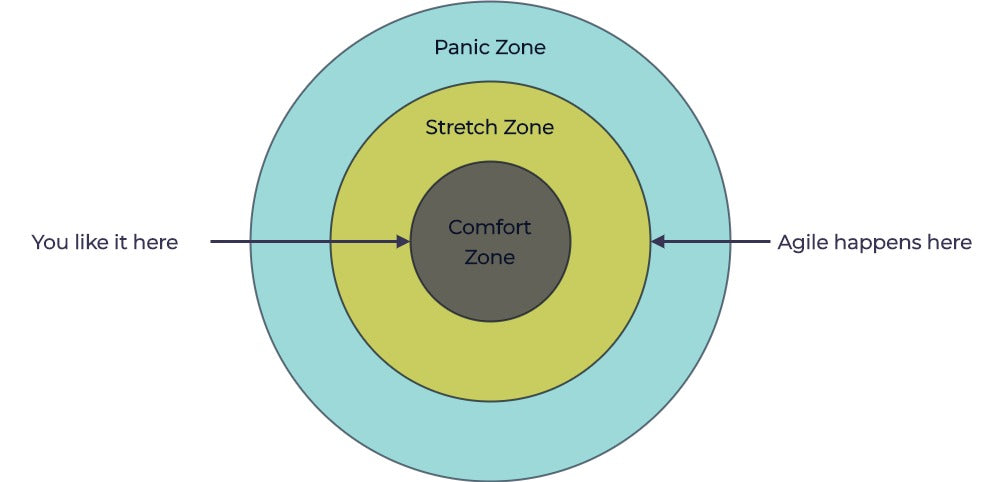The Psychology of an Agile Mindset
Share
Job postings for Scrum Masters, Agile Coaches or Agile Leaders all have one requirement in common. It is always part of the job to train and support an agile mindset in the team, the organization or the company. But what does it actually mean to have an agile mindset? How can it be established and supported? And why is it so difficult to establish an agile mindset at all? This article sheds light on the psychological background of an agile mindset and answers the above questions.
The Manifesto for Agile Software Development
On February 11-13, 2001, at The Lodge at Snowbird ski resort in the Wasatch mountains of Utah, seventeen people met to talk, ski, relax, and try to find common ground—and of course, to eat. What emerged was the Agile ‘Software Development’ Manifesto. Representatives from Extreme Programming, SCRUM, DSDM, Adaptive Software Development, Crystal, Feature-Driven Development, Pragmatic Programming, and others sympathetic to the need for an alternative to documentation driven, heavyweight software development processes convened.
With this sentence the article “History: Agile Manifesto” by Jim Highsmith from 2001 begins. Since then, the “Manifesto for Agile Software Development” has become a northern star of software development. People around the world strive for better software products by following the four values and 12 principles of the Agile Manifesto. However, some of these principles are more difficult to put into practice than others. When you think about the general perception of an “agile mindset” in the software industry, there are two principles that stand out a bit. Unfortunately, these are also the two principles that are most difficult to put into practice.
Welcome changing requirements, even late in development. Agile processes harness change for the customer’s competitive advantage.
At regular intervals, the team reflects on how to become more effective, then tunes and adjusts its behavior accordingly.
These two principles describe completely different aspects of software development. Nevertheless, they trigger the same psychological effects in humans. Both principles not only present change as something positive, but also require that teams should view change positively and welcome it. The rest of the article describes the psychological effects that are triggered by this and what this means for the establishment and training of an agile mindset.
Psychological States
The comfort zone model represents the conditions under which we as humans can best learn and develop. There are three zones, namely the comfort zone, the stretch zone and the panic zone. The graph of the comfort zone model gives you an overview of the respective zones. The next paragraphs give a brief overview of all three zones and their characteristics.

The Comfort Zone
This is man’s favorite zone. In the comfort zone there is the known, the safe and already existing. When you are in your comfort zone, you are acting out of habit. This gives us a safe and good feeling. In this zone we have the feeling of not being overstrained and of having everything under control. Unfortunately, it is also almost impossible to develop and learn new things as long as we are in our comfort zone. The comfort zone is the opposite of change.
The Stretch Zone
Stepping out of the comfort zone can mean something different for everyone. For some it can mean dealing with new technology. For others, it can mean doing without technology. However, the step out of the comfort zone has something in common for all people. Here we let go of familiar patterns and make new experiences. These broaden our horizon and help us to grow with our environment and our challenges. This normally feels unfamiliar and new, so that the desire to return to the comfort zone, to familiar, learned behavior patterns, can arise. In this zone we can change not only our own actions but also the way we perceive and evaluate things. Our own limits are shifted and expanded. Here active change takes place.
The Panic Zone
In the panic zone, a person has left his comfort zone so far that the usual limits are far behind him. This is where sheer fear and insecurity prevail. At this point there is only one need. The fastest possible return to the comfort zone. In the panic zone, the chance for change and learning is very small, because the person feels completely overwhelmed by the overall situation. This experience can be so traumatizing that the existing limits become manifest and even steps into the stretch zone become unlikely.
The Yerkes–Dodson Law
The Yerkes-Dodson law is an empirical relationship between pressure and performance, originally developed in 1908 by the psychologists Robert Yerkes and John Dodson. It describes that performance increases with physiological or mental excitation up to a certain point. If the level of arousal becomes too high, the performance decreases. However, this only applies to complicated or difficult tasks. Simple tasks can be performed with sustained high performance even when the degree of arousal is high.

This explains why teams in sports get worked up in the locker room before a game. It helps them to perform at a higher level. Furthermore, stage fright among artists and speakers is also positive up to a certain point and contributes to an increase in the quality of the performance. However, only up to a point where the actors seem paralyzed and they are no longer able to perform. Since software development is also a complicated task, it is obvious that teams perform better when they feel challenged and put under a certain amount of pressure.
An Agile Mindset and its Implications
Let us now take a look at the effects that psychological states and the Yerkes-Dodson law have on the idea of an agile mindset. We have seen that people love it most when they are and can stay in their comfort zone. This means that they love a stable, trustworthy and comfortable environment where they have a sense of security and control.
On the other hand, we have the agile principles of accepting change and the constant search for adoption and improvement. As we have learned, the best and usually only way to change things is to step out of the comfort zone. So we have a discrepancy between the state of mind that people love and the state of mind that enables agility.

In other words, the key to a successful agile transformation and everything that goes with it is to get your employees out of their comfort zone. Constantly. Over and over and over and over again. It’s very difficult because employees love their comfort zone so much. Therefore, it is not a task to establish an agile mindset in a company. It is a journey. It is a long and winding road, with potholes and missing road markings.
It is not a task that you can put on an “agile roadmap” and check off when you are done. Establishing an “agile mindset” means that you have to challenge your teams and team members again and again until an agile way of thinking and working becomes a new habit. People have to get used to living outside their comfort zones, and then your organization will be able to think and work agile. Opportunities to do this are anchored in your organization’s performance management and cultural approach to enable people to step out of their comfort zone.

Fortunately, this is not only associated with constant struggles, refresher workshops and setbacks. If we take a closer look at the relationship between the three psychological states and the Yerkes-Dodson Law, we can see that there is also a great benefit from it. The stretching zone is also the zone where human performance is strongest. This means that stepping out of the comfort zone not only enables mobility, but most likely improves the overall performance of the organization.
Final Thoughts
We have seen that establishing an agile mindset is not as easy as it may seem. First of all, it is not through the decision of your board of directors that you become an agile company. You cannot just flip the switch and be agile. It’s also not something you can put on a to-do list and check off when you’re done. Building an agile mindset is based on leaving the comfort zone. Your personal comfort zone, the comfort zone of your team, the comfort zone of your organization, every day and all the time. Being agile means constantly challenging the status quo and doing so with pleasure.















